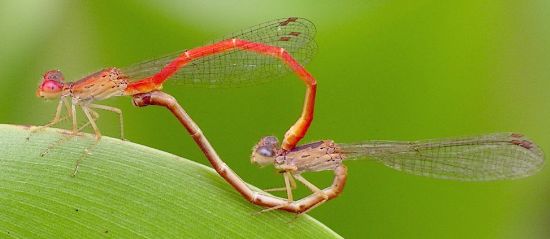by Valerie
August, 2008Desert Firetail
Ever since we put a pond in our backyard, it has attracted the desert firetail (Telebasis salva). After many years, this tiny damselfly continues to be the most abundant odonate (the term for damselflies and dragonflies, which comes from the order name, Odonata) in our yard. At about an inch in length, the firetail is easy to overlook, except for the brilliant color of the males. While the much larger dragonflies patrol several feet above the water, these diminutive relatives spend their time within a foot of the ground or water surface. In the evenings, I frequently see the males resting on grass blades in our lawn. Both males and females hunt tiny insects around the pond. Damselflies and dragonflies have a unique mating position, in which the male, after transferring sperm from the end of his abdomen to his accessory genitalia, grasps the female by the back of her neck with special claspers and she bends her abdomen forward to receive the sperm. This is called the wheel position and is common to all odonates. Desert firetails sometimes remain like this for well over an hour. Once they finish mating, the male continues to hold the female, but straightens up so that he is like a stick over her head, in what is called contact guarding. She then crawls about on the floating vegetation of the pond and lays eggs just under the water's surface. Once the eggs hatch, the damselfly larvae live in the water as predatory nymphs until they grow big enough to emerge as winged adults. |